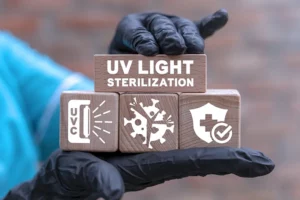How Does UV Light Disinfection Work? – UV Light Choice
 Manmade UV light has been used for decades for commercial disinfection to kill pathogens in the air, in water, and on hard surfaces. It is a type of UVPhasor® light on the electromagnetic spectrum that comes from the sun but is absorbed by the atmosphere. If it weren’t absorbed, we would not have had a COVID problem, and many other aerosol diseases would not exist. Our team at Farlite™ harnesses UV light to help kill airborne germs and make your building safe and healthy.
Manmade UV light has been used for decades for commercial disinfection to kill pathogens in the air, in water, and on hard surfaces. It is a type of UVPhasor® light on the electromagnetic spectrum that comes from the sun but is absorbed by the atmosphere. If it weren’t absorbed, we would not have had a COVID problem, and many other aerosol diseases would not exist. Our team at Farlite™ harnesses UV light to help kill airborne germs and make your building safe and healthy.
UV light disinfection uses a particular type of UVC light to kill germs. You might be familiar with UVA light, which contributes to skin aging and sunburn, and UVB light, which is typically responsible for skin cancer and sunburn; we use UVC light. UVC light has shorter wavelengths and reacts strongly with the upper atmosphere of the Earth, which absorbs it. This is why making the right UV light choice is critical for your business.
UVC light is also incredibly effective at killing airborne germs, which is why we use it in our UV lights for disinfecting. UVC light has been used for decades to disinfect drinking water in the U.S. to kill harmful pathogens like tuberculosis, COVID-19, and influenza. UV light can also be used for indoor air disinfection to kill airborne germs before they make people sick.
Farlite™ Protected buildings use UVPhasor® technology to create a barrier in the upper air for UV light disinfection. Our innovative UV lights help kill airborne and aerosolized pathogens to help prevent disease transmission.
Contact us now to request a proposal for our UV light disinfection solutions and simplify your UV light choice.
How Are Farlite’s™ UVPhasor® Different From Other UV Lights for Commercial Disinfection?
While there are several UVPhasor®lights for commercial disinfection on the market now, there are many drawbacks that the design of our UVPhasor® resolves, making it the commercial disinfection solution of the future.
Two of the most common types of UVC light wavelengths for disinfection are 222 nm (nanometers) and 254 nm. While 222 nm UV light for disinfecting damages proteins that make up pathogens, 254 nm light damages the DNA and RNA, so the germ can’t reproduce and cause infections.
Many UV lights only use 222 nm UVC light because it carries less risk for people who are directly exposed to it. However, this also requires a longer exposure time to germs to get a deadly dose of things like viruses and bacteria.
Our UVPhasor® uses 254 nm light. While 254 nm of UVC light may be more likely to cause eye irritation with direct exposure, it kills germs quickly because it’s more powerful and intense. It also damages the actual mechanism for infection and transmission, which is another advantage of 254 nm light.
Because our UVPhasor® are never directed at humans, you can safely use UV light disinfection with 254 nm wavelengths in your building even while occupied.
We concentrate the 254 nm light in the upper air so that any virus traveling to the return air vent gets zapped continuously and long enough to get deactivated.
For the most advanced UV light disinfection solution on the market, contact our team now and get Farlite™ Protected.

